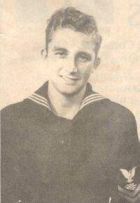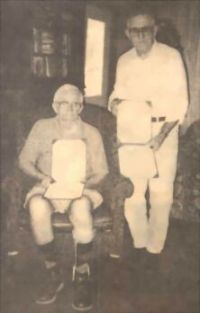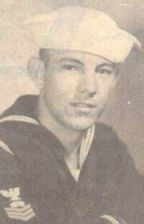|
More than 50 years has not dimmed the memory of the day 16 Army B-25 bombers aboard a carrier were escorted across the Pacific Ocean to enemy territory and sent on a do-or-die mission.
Two central Texas veterans recently were cited for their role in helping the Doolittle raiders carry out their mission - take off from the U.S.S. HORNET 500 miles from Japan, raid Tokyo and other large Japanese cities, then fly across the Yellow Sea and into China.
E. C. "Buddy" Porterfield of Eddy, TX. was serving as a radioman 3 class aboard the U.S.S. SALT LAKE CITY on April 18th, 1942. It was just 4 1/2 months after the Japanese attack on Pearl Harbor. The U.S.S. SALT LAKE CITY, a heavy cruiser, was part of Cruiser Division 5 that was escorting the carrier U.S.S.HORNET to its destination.
As a radioman, Porterfield knew what was about to happen.
"We met the U.S.S. HORNET loaded with B-25s north of Midway and escorted her to within 840 miles of Japan. We knew those planes were to going to bomb Tokyo, Kobe, Hiroshima and Nagaski," Porterfield said.
Mart, TX. resident Robert Storey was assigned to the relay room at Turret 4. He said he did not know what was about to take place until he went up on deck where he could see the U.S.S. HORNET.
"I remember me and the guys were talking about something's going on over there," Storey said. "One guy said 'That don't look like dive bombers'."
Binoculars zeroed in on the U.S.S. HORNET as speculation about the carrier's cargo ran rampant among the crews of the accompanying ships.
It was not until the ships reached the point of take-off that most of the crewmen realized the raid was about to happen.
"We were suppose to be closer to 500 miles from Japan to launch to have enough fuel to make it across the China Sea and into China but the waters were to choppy," Porterfield said.
The plan called for Lt. Col. James H. Doolittle to take off three hours early at 2 p.m. to strike at dusk starting large fires for the other aircraft to target later that night.
The navigators, who were accustomed to overland flights, would be expected to travel 500 miles over open sea to a hostile city and accurately drop bombs on defense installations, avoiding civilian areas nearby.
After the attack, the pilots would travel another several hours over an aroused and well-armed enemy, an unfamiliar sea, and then, with fuel running low, to a strange field in a country where large areas were occupied by the enemy.
Despite the distance and adverse weather conditions, the B-25s took off early for Japan since danger lurked in the enemy waters. At 668 miles from downtown Tokyo, Doolittle and his men stood ready. The sea was so rough that solid water was coming up over the bow of the U.S.S. HORNET.
The plane directors coordinated their "go" signals with the rise and fall of the sea sending the bombers on their mission just as the bow rose on a crest wave to give them a few more feet of altitude and an upward thrust. It took an hour to launch the 16 B-25s while all the men in the task force whose duty allowed them to watch had their eyes on the bombers.
"It was a no-return deal, a flight of no-return," Porterfield said. If the raid was not successful, the pilots would either be captured, then killed or dilled during the attack, he added.
The ships that escorted the U.S.S. HORNET were told to turn around immediately after the launch.
"We were told there might be a Japanese fleet out there," Storey said. "We were told to be on alert around the clock because we were in dangerous waters. Thank goodness we didn't run into any of them."
The combined task force was on its way in the opposite direction at 25 knots within two minutes.
Porterfield, who was in the radio shack at the time of the raid, said the airwaves out of Japan became silent.
"We knew the planes made it to Japan without being detected," he said.
Storey said he has heard some pilots who were in the raid say they were flying so low over Japan they could see the people.
One plane went down in the raid with the pilots begin taken prisoner and later killed.
The raid was a huge boost to the morale, Storey and Porterfield agreed.
"It took pressure off the Philippines and Singapore. It gave the people back in the states some hope," Porterfield said.
Storey added, "The Japanese found out we could bomb them. That's what really hurt them."
Porterfield later received the Air Medal for helping to rescue a downed pilot within reach of enemy fire. He prevented his plane from capsizing by climbing up one of the wings until the other wing, which was partially submerged, resurface. He lightened the plane to make room for the additional passenger by jettisoning the machine gun installation and loose gear, including his own parachute.
Storey was transferred to the repair party after the Tokyo raid.
"We were suppose to keep the thing afloat. I guess we did a pretty good job," he said.
Porterfield and Storey, who did not know each other aboard the U.S.S. SALT LAKE CITY, but became acquainted at a reunion of the ship's crew, are both retired.
The Department of the Navy is recognizing the services of the sailors who participated in the Doolittle raid through Task Force 16. The citation, issued May 15, 1995, states in part:
"Facing adverse weather conditions and under constant threat of discovery before the bombers could be launched to strike the Japanese homeland, the crews of the ships and LTC Doolittle's bombers persevered.... These raids were an enormous boost to the morale of the American people in those early and dark days of the war in a harbinger of the future for the Japanese High Command that had so foolishly awakened 'The Sleeping Giant.' These exploits, which so inspired the service men and women and the nation, live on today and are remembered when the necessity of success against all odds is required."
Task Force 16 included U.S.S. HORNET CV-8, U.S.S. NORTHAMPTON CA26, U.S.S. SALT LAKE CITY CA25, U.S.S. BALCH DD363, U.S.S. BENHAM DD397, U.S.S. ELLET DD398, U.S.S. FANNING DD385, U.S.S. SABINE A025, U.S.S. ENTERPRISE CV6, U.S.S. VINCENNES CA44, U.S.S. NASHVILLE CL43, U.S.S. GWIN DD433, U.S.S. GRAYSON DD435, U.S.S. MONSSEN DD436, U.S.S. MEREDITH DD434, U.S.S. CIMARRON A022 and submarines U.S.S. THRESHER SS200 and U.S.S. TROUT SS202
Anyone who served in Task Force 16 and has not received their commendation, may contact
S. J. Kirk
Navy Operations Awards and Special Projects
1000 Navy Pentagon
Washington, DC. 20350-1000
|





